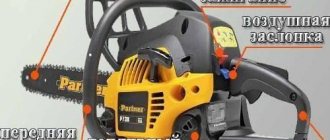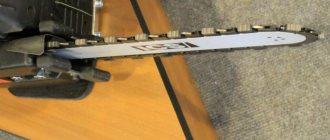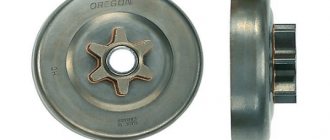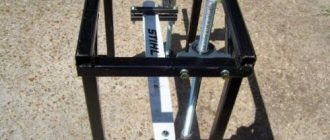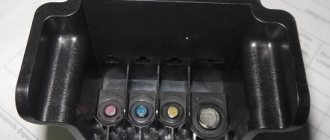It is not uncommon for situations when, when installing a shorter bar on a chainsaw, you also have to change the saw chain. This information will tell you how to shorten the chain on a chainsaw so that the part completely exhausts its service life. In another option, it is possible to fit a long chain to a shorter standard guide bar.
For repairs, unstretched chains with a relatively short lifespan are used, which have received partial damage when they break or the cutting links get into metal inclusions contained in the wood.
The feasibility of self-repair
Experts advise riveting and repairing a damaged chain with minimal loss of quality using the technical potential of a service workshop. Despite manufacturers' assurances about the problems and difficulties of self-repair, a significant portion of users prefer to learn techniques for restoring the functionality of saw sets on their own.
The reason for this phenomenon:
- the owner lives at a great distance from service and maintenance points;
- high cost of repair services provided;
- lack of necessary equipment.
Compensating for natural chain wear by shortening is neither advisable nor safe. Operating a saw set with a stretched chain is inevitably accompanied by:
- forced wear of the tire and drive sprocket;
- increased load on the engine;
- increased risk of injury from sawing work of various levels of complexity.
External and internal factors of accelerated wear
The reason that the chain on a chainsaw is stretching intensively may be the wrong choice of chain oil or the replacement of the recommended material with an oil substitute, a malfunction of the lubrication system, or inaccurate adjustment of the oil pump with variable performance.
Filling the lubrication system with material of substandard density and viscosity negatively affects the lubrication and cooling efficiency of working surfaces, and the performance of the pump supplying chain oil to the saw set.
Refilling summer oil can create many problems when operating a chainsaw at low air temperatures of -10°C. As a result of an oversight, the oil pump drive may break down, reducing its performance to the level of oil starvation.
How does a chainsaw chain lubrication system work?
The chainsaw is constantly lubricated by an oil pump. The oil hose ends at the point where the bar connects to the crankcase of your existing chainsaw. In turn, the chainsaw headset has a hole or grooves through which the standard oil is dispersed throughout all working parts.
The design and operating principle of the lubrication systems used in modern chainsaws is distinguished by its simplicity. This makes it possible for every owner of a gasoline tool to repair the mechanism.
Possible causes of spontaneous saw chain breakage
If the chain on a chainsaw breaks, it is necessary to find out the cause of the malfunction and determine the feasibility of repairing the damaged part or installing a new one.
Typical causes of saw chain breakage are unfavorable external factors:
- excessive tension;
- wear of the guide bar or discrepancy between the shanks and the width of the working groove;
- operation of the saw set with large constant loads;
- overheating of the headset due to lack of lubrication;
- the chain does not match the type of tire and the configuration of the drive sprocket crown.
How to shorten a chainsaw chain with your own hands?
Some novice gardeners do not know what to do if the chain on the chainsaw stretches. In this case, it will need to be shortened. To do this, you need to prepare the necessary tools:
- Hammer and vice;
- Beard;
- Needle file;
- Pliers;
- Electric welding machine.
To shorten the chain on a chainsaw, you must proceed in this order:
- First you need to disconnect its links. You should not use a grinder for this, as this can cause the carbide links to become deformed. It is best to use a file or needle file for this. You need to grind each link on both sides, and then unscrew the rivets from the chain using a bit;
- After you have managed to rivet the chain, you do not need to immediately throw away the detached rivets. They may be required when you make further repairs to the saw element;
- At the next stage, you will need to rivet the chain, that is, connect the shortened saw element. To do this, you need to count the teeth and connect the links to the rivet, pressing their side parts;
- After this you need to start welding the links. In this case, you should act extremely carefully, otherwise poorly welded parts of the chain will scratch the chainsaw bar;
- Next, many beginners have a question: “How to rivet a chainsaw chain?” To do this you need to use a regular drill. Take a nail with a diameter equal to the diameter of the inner part of the rivet and cut a 7-centimeter blank;
- Next, fix the workpiece in the drill head. Then attach 2 files to the beam so that the distance between them is equal to the width of the inner part of the rivet. At the same time, you are required to achieve maximum accuracy. Next, you just have to take care of the uniform supply of the block to the workpiece.
After you have been able to repair the chainsaw chain with your own hands, you need to inspect it for burrs. If necessary, remove them using a file. In the future, if the chains on your chainsaw break quite often, we recommend purchasing a special chain riveter. It will help you save a lot of time and effort. Many experts also advise replacing conventional chains with pobedit-tipped saw elements. The fact is that a Pobedite chain for a chainsaw is much more reliable and will not break as often as regular saw chains. However, the performance of the saw when using such a saw element will drop slightly.
Features of home renovation
Many experienced users prefer to repair chains themselves. The success of the work performed is determined by the presence of special skills and tools, knowledge of the design features of models for various purposes.
In particular, dismantling and assembling wear-resistant analogues does not create difficulties. The carbide compound is applied only to the cutting edges of the saw links. As for connecting elements and rivets, standard metal is used for their production.
With greater or lesser success, you can rivet a chainsaw chain at home, and if you have the right tools, even in the field. Please note that during subsequent use of a self-repaired headset, special care should be taken. At the first opportunity, it is advisable to have the connection repaired in a hospital.
Tools needed for shortening
You can properly shorten a chainsaw chain with your own hands using special tools.
Rivet Removal Machine
For disassembly, a specialized machine is used - a punch. The machine is designed in the form of a small mechanical press. A removable anvil is installed in its lower part, which has grooves of different sizes. The working rod of the device also has nozzles of different diameters. This makes it possible to use the machine for chains from various manufacturers. The rivet is removed by squeezing it out of its seat.
Riveting machine
Attention: the diameter of the removable tip of the working rod must not exceed the diameter of the hole in the side plates.
Rivet setting machine
After disassembling and removing the chain element, it is necessary to reconnect the working links. A riveting-rolling machine is used for this purpose. The assembly process takes place using a special work roller, which is driven by an electric motor.
Electric riveting and rolling machine
The rivet is clamped between a stationary anvil and a working roller. The operator independently sets the pressure of the working roller using an adjusting screw. As the roller rotates, the edge of the rivet is gradually crushed, making it impossible to separate the links from each other.
Help: using machines to shorten a chainsaw chain allows you to bring the build quality as close as possible to the factory model. However, these devices are quite expensive, and purchasing them for use at home is unprofitable. In addition, it is not always possible to use specialized devices directly at the workplace. In this regard, shortening can be done with improvised tools.
Post-repair restrictions
The problem is that the hastily repaired part contains one or more “weak links”. In this state, the operating time of the headset under heavy loads is significantly limited, and increased demands are placed on the full operation of the lubrication system.
It is possible to use the restored chain in operating mode, provided that the repair was performed by an experienced riveter who has a riveting machine and other special equipment at his disposal.
Is it always necessary to repair the chain?
A sagging chainsaw chain is not always a reason to repair it.
You must first make sure that it is definitely not subject to tension (adjustment). Here are some typical cases:
- Chain stretches.
- The new existing circuit does not match the short bus.
Find out how to make a router from a drill with your own hands:
Chain stretching due to prolonged operation is a typical case. During operation, the metal of the chain heats up, and the links gradually stretch due to the expansion of the metal in volume. That is, the chain is stretched every time, which can sometimes be eliminated by partially reducing the cutting time. However, this is not an option when she has to work intensively for the entire shift in an industrial environment or when collecting firewood for the winter.
Another circumstance that does not allow the saw to be used normally even with a new chain is the discrepancy in length. This can only happen when purchased by inattentive users, or is caused by the current lack of the required chain. Which, in principle, is not so dangerous, since you can always find a way out by shortening it manually. At the same time, the strength of the connection of the chain links will remain at a fairly high level.
Adjusting chain tension
Adjustment of chain tension is usually done manually using the saw tension bolt located in the area of the dog teeth.
Using a straight screwdriver mounted on the bar and drive sprocket, after closing the side cover, begin to gradually tighten the chain.
You should not tighten the chainsaw chain all the way, as you risk stretching the links again soon. Usually, a small reserve of chain stretch is left, which can be checked by hand. It should be slightly retractable from the tire by about a millimeter.
The initial stage of repair and restoration work
All known methods of shortening a saw chain require criteria for the rejection of damaged cutting and connecting links and a technology-defined sequence of work operations. The cutting and connecting links are mounted with factory rivets, which in all respects comply with current standards.
The use of homemade components is not recommended in any case. Special rivets for chains are extremely rare on sale, so in most cases the problem is solved by installing the necessary parts removed from the dismantled section of the chain.
What types of chainsaw chains are there?
Today the market is filled with many varieties of saw elements. They are divided according to their characteristics and are divided into several categories.
According to the type of sawing direction, the following types of parts are distinguished:
- transverse - a saw set of this type is characterized by the effect of smoothing vibration and reducing the load on the tool’s engine. This makes using the saw easier and more convenient;
- longitudinal – parts of this type are distinguished by their high performance.
Another important characteristic is the pitch of the chainsaw chain.
Based on this factor, saw sets are divided into the following types:
- 0.25 or 1/4" - these parts are equipped with one-handed household saws;
- 0.325 or 3/8" - elements with this pitch are most often equipped with semi-professional tools;
- 0.404 or 3/4" - such parts are suitable for use on concrete or aerated concrete.
As a rule, the performance of the headset directly depends on the step.
The third characteristic is the thickness of the shanks. To install the element, this parameter must match the dimensions of the grooves in the tool tire. This way, the headset will be firmly fixed to the tire, and the risk of it accidentally slipping off will be minimized.
The following types of parts are available for sale:
- chains with a shank thickness of 1.1 mm - these parts are used for working with household tools;
- elements whose shank thickness is 1.3 mm - this type of headset is used to equip semi-professional chainsaws;
- products whose shank thickness is 1.5 mm are used for regular equipment of small but powerful household tools;
- parts whose shank thickness ranges from 1.6 to 2 mm - this set is mounted only on powerful industrial saws.
Many experts also divide the working parts according to the possibility of installing them on chainsaws with a self-sharpening function. Based on this property, there may also be a self-sharpening headset or chain on sale that needs to be sharpened by hand.
Sequence of dismantling and subsequent assembly
At home, it is easier to disconnect the chain by sawing off the heads with a file, after which the shortened rivets are easily knocked out with a thin steel rod. The task is simplified by the presence of a release clamp that is suitable for the pitch of the chain. The rivets removed by such a device can be used without restrictions.
You can independently connect the ends of a shortened chain in a bench vice. The rivets threaded into the chain elements on the reverse side along the circumference are flared with light blows of a medium hammer. The finished connection should not have any play, and a tight fit should not be allowed.
When assembling different types of saw chains, it is necessary to observe the dimensional intervals between the cutting links prescribed by the design.
If there is a need to shorten
Often, when working in the forest or on a remote construction site, you will not be able to find a replacement for a stretched chain.
Having taken into account all the advice and made sure that it is necessary to shorten the chain, it is important to know the sequence of actions and possible replacement methods.
There are not many of them and they depend on how many links need to be removed and under what conditions the repair will be carried out.
This is important to know: a chainsaw chain consists of cutters and connecting links, which are connected with rivets in the factory. The shortened chain should be connected in the same way, but using homemade rivets.
Each link (the cutter and the links connecting them) has two such rivets. If nearby “native” connecting links are damaged, you can use elements from any other similar circuit of any equipment, even automotive equipment. You just need to file the profile, especially at the bottom, where it has a small groove.
Chainsaw circuit diagram
We also suggest that you read about the rules for using electric welding for beginners in the following article:
The easiest way is to take a long chain, in which several segments can be removed without problems. This way, at least, it becomes possible to use family links. They can be removed using a hacksaw, but it is better to use sandpaper.
Initially, you need to grind off unnecessary rivets, and then cut off the excess area. To do this, you need to pry it with a knife and knock out the rivets from the unnecessary links using a homemade knockout.
When connecting a new chain, you have to make homemade riveting of the links. The rivets themselves can be bought at the store, but if you don’t have them, use steel wire, or better yet, a short bolt with a flat head. Riveting is done on a rigid base (metal workbench or vice). Alternately threading through the elements of future rivets, use a hammer to flare them from the reverse side.
You may also be interested in the article on sharpening a chainsaw chain with your own hands. You can read about the types and characteristics of modern chainsaws here.
And in this article you can find out how to repair a Shtil 180 chainsaw.
Range of saw chain repair machines
A special machine for riveting chainsaw chains is included in the list of working equipment of specialized workshops. The offered range includes several budget and branded imported models costing from 2000 to 5500 rubles.
Riveting machines from the brands Shtil, Husqvarna and Champion are characterized by increased capabilities and a comfortable level of work.
The cost of universal Shtil NG-7 riveting machines is about 18,000 rubles. Technically advanced devices ensure high quality riveted joints, saving working time and material resources.
The cost of a special machine for sharpening chainsaw chains varies from 2000 to 6000 rubles
Repair standards and restrictions
Recommendations for fixing ground rivets by electric welding do not take into account changes in the structure of the metal due to even short-term high-temperature effects of the welding arc.
Grinders stuck by welding or heated by an abrasive wheel, the connecting elements of the chain are less wear-resistant, which significantly affects their reliability.
- A tight connection of adjacent links is accompanied by additional loads on the engine and kinematics of the chainsaw.
- The lack of a smooth movement of the chain makes it difficult for the headset to enter the cut; the possibility of kickbacks and other traumatic moments cannot be ruled out.
- “Over-tightened” and loose connections of a repaired chain are more susceptible to breaks when there is a sudden change in load.
The simplest machine in design for repairing chainsaw chains justifies its cost by being able to completely rivet a damaged chain in a short period of working time and restore its performance to a level of up to 90%.
Chinese-made chainsaw chains are essentially copies of European models, so the above repair recommendations are valid for the entire Chinese chain range.
How to properly put a chain on a chainsaw: instructions, recommendations, basic methods
Chain
- a fundamental element of the chainsaw design.
Specifically, it bears a heavy load during operation
, and therefore requires high-quality and systematic care.
When using any model, it is important to know how to properly put on the chain
and watch its tension. If you fasten it incorrectly, there is a risk of stretching and coming out of the grooves. The productivity of the saw decreases, and the risk of injury at high power also increases.
Lead star problems
From time to time, chain slack occurs due to problems with the drive sprocket. A more common situation is when it is poorly secured. Step-by-step method to tighten the sprocket:
- Remove the motor protective cover.
- Remove the air filter and unscrew the spark plug, placing in its place a special stopper to fix the piston in a stationary position.
- Using an angle grinder wrench, rotate the clutch disc clockwise to its highest position. Check the tightness of the sprocket and adjust its position. Sketch 3 – Chainsaw Lead Star
After clamping, assemble the chainsaw back, be sure to put on the protective cover. When assembling, you should check that the chain fits tightly onto the bar.
Criteria for self-selection of saw chain
In everyday life, the quality of removable saw equipment from leading European brands is highly valued. Guide bars and chains from the Stihl and Husqvarna brands enjoy unofficial status as reference products.
When purchasing a product, you must make sure that the model meets the design standards of the chainsaw in terms of length, pitch and shank thickness. The entire chain range is divided into five size groups with intervals from 1/4 to ¾ inches.
Products with a smaller pitch are equipped with small-cube models of budget-class chainsaws, chains with an increased pitch and thicker shanks are a characteristic feature of sets of powerful and productive professional chainsaws.
How is a chainsaw chain lubricated?
It should be noted that when operating a chainsaw, not only the tire, but also the tool chain receives oil. After oil gets on the tire, the saw element is activated, the links of which are also equipped with grooves or holes. As the engine speed increases, the speed of oil movement along the bar and chain also increases. Some models of modern chainsaws are equipped with special mechanisms that allow you to increase or decrease the amount of oil required for the chain to function properly. Lubrication of a chainsaw with this function is quite convenient, as it saves oil and prevents the chain from slipping on the bar due to an excess of lubricant. Very often, beginners do not know how to lubricate the needle bearing of a chainsaw. This element requires lubrication no less than the tire and chain. Experts advise using special greases from the manufacturers Stihl and Husqvarna as a lubricant. To add lubricant, use a syringe so that all the product gets inside the bearing. If you ignore the need to lubricate the needle bearing, then the result will be the replacement of the drive roller and a number of other important parts of the chainsaw.
How to eliminate the risks of purchasing a low-quality counterfeit
When purchasing a branded chain on the market, the risks of purchasing a counterfeit Chinese chain cannot be excluded. The task of independent choice is complicated by the lack of a reliable way to distinguish a high-quality branded original from a fake, which is an order of magnitude inferior to branded products in terms of working life.
With greater confidence, you can identify Shtilevsky chains by their silver packaging, bright orange logo and the presence of a wear indicator. Cheaper Chinese analogues are decorated more modestly, in gray boxes with a yellow trademark.
Without fear, you can buy saw chains of high quality and durability in company stores and licensed sales offices of intermediary companies.
